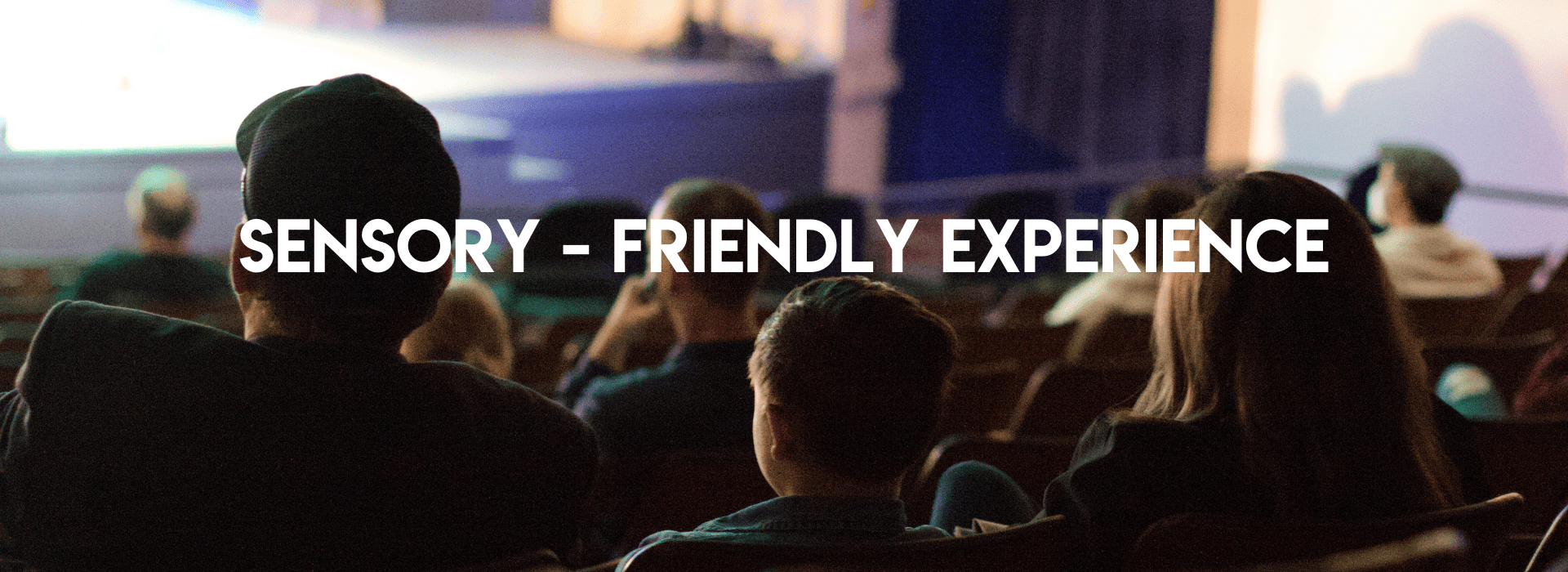
SENSORY-FRIENDLY PERFORMANCES
Sensory-friendly performances are designed to create a welcoming environment for people who are on the autism spectrum or may have sensory sensitivities.
The integrity of the performance remains the same, while production elements are modified to accommodate individuals with sensory needs allowing families and friends of those with autism or other disabilities the opportunity to enjoy an authentic performance experience together.
Our goal is a relaxed and judgment-free theatre experience where audiences can move around or take breaks in the lobby, sing or talk during the performance, or wear sunglasses in the auditorium. We welcome you!
Modifications include:
BEFORE THE PERFORMANCE
- Limited crowds and visitors during the day and timing of the performance
- Doors open one-hour prior to curtain, to help familiarize patrons with the spaces and experiences they will encounter while attending this show.
- Limited crowds with open seating to allow space between groups
- Meet the staff, ushers, and volunteers that are trained to be inviting and accommodating to families’ needs
- Access to Social Stories guide to social information about the experience of attending Magik Theatre and enjoying the performance. ( Gain access pre-visit and available onsite day of performance)
- Sensory regulating toys will be available in the lobby
DURING THE PERFORMANCE
- House lights remain on at a low level in the theater during the performance
- Sound levels are lowered, especially startling or loud sounds, while preserving the original sound quality
- A reduction of strobe lighting and lighting focused on the audience
- Patrons have the freedom to talk and leave their seats during the performance
- Entering and exiting the auditorium will be allowed throughout the performance
- The lobby monitor will allow patrons to continue watching the performance if there is a need to leave the seating area at any point during the performance.
- Electronics are allowed for therapeutic use
SENSORY INCLUSION FAQ
What is the sensory inclusion initiative?
The sensory inclusion initiative is designed to help arenas, zoos, aquariums, museums, restaurants
and other places of public attraction better entertain their guests that might have sensory needs/
sensory processing issues.
What is a sensory need/sensory processing issues?
A sensory need/sensory processing issues is one where the guest affected by this finds noises,
smells, lights and even crowds not only overwhelming from the sensory perspective but also
sometimes physically painful. Because of this, these guests often find themselves isolated from
the community.
What is the difference between sensory inclusion and sensory friendly?
Sensory friendly is one where the location has had all the potentially noxious stimuli removed.
Because this is sometimes a difficult task, accessibility is therefore limited to the day and location
of the sensory friendly event. Sensory inclusion liberates that. It creates daily accessibility with
training, tools and other modifications that although do not remove the noxious stimuli. help the
guest cope with this potential sensory over stimulation better thus ensuring an accepting and
inclusive experience for all.
What are some groups that are affected by sensory need/sensory processing issues?
These could be guests with PTSD, autism, early onset dementia, anxiety, stroke patients just to
name a few.
How does partnering with KultureCity help?
KultureCity helps by providing the necessary training to better entertain guests with these needs.
They also provide signage, weighted lap pads, sensory bags that contain noise cancelling
headphones, fidgets tools and much more in order to truly create a welcoming experience for
these guests.
What is the end result of the initiative?
It helps all guests feel welcome and included in our locations. It also helps us reach a huge portion
of our community that has long been isolated.
How many people have a disability in the USA?
1 in 5. With 16% having visible disabilities and the remanding 84% with invisible disabilities like
PTSD, autism, dementia, strokes etc. The common denominator for these groups are sensory
issues.
EXPERIENCE THE ARTS
SOCIAL STORIES GUIDE - Online
SOCIAL STORIES GUIDE - Download
2024-2025 Sensory-Friendly Performances
Lyric & The Keys
- Saturday, October 5, 2024 at 10:00 am
The Velveteen Rabbit
- Saturday, November 30, 2024 at 10:00 am
Elephant & Piggie’s “We Are in a Play!”
- Saturday, February 15, 2025 at 10:00 am
¡Lotería: Game On!
- Saturday, May 24, 2025 at 10:00 am
